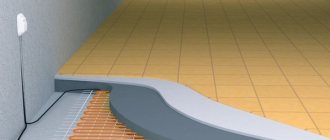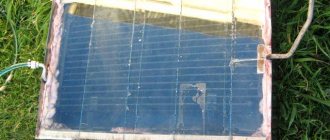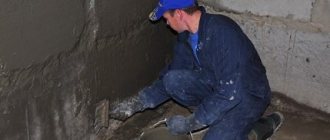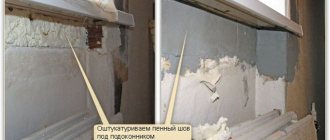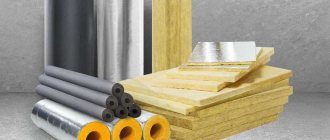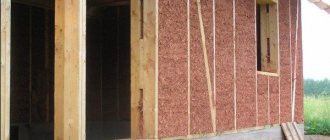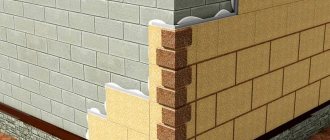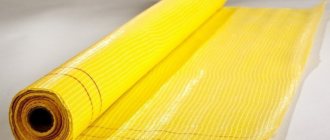What is resistive heating cable
I will answer the question of what a resistive heating cable is from the very beginning.
- Resistive cable - electrical. That is, to complete your tasks, which are discussed below. It needs to be connected to the power supply, plugged into a 220 Volt electrical network.
- This cable is heating. This means that when you plug it into the electrical network, it starts to heat up. The process of heating a resistive cable is not an emergency. This is the normal operation of heating cables based on their characteristics.
Product installation
Correct installation is the key to correct and durable operation of the equipment. There are several points to consider that you should definitely pay attention to. There are four installation methods:
- Laying the cable in one straight line. It lays flat, without any zigzags or bends. In this method, several cables are most often used at once, which are laid side by side.
- Laying can also be done with a wavy line. In this case, the wire wraps around the pipe a little.
- Spiral laying. The cord is wrapped around the pipe.
- Separate sections of cable that lie along the contour.
A heating cable is a very useful product for use in private homes, as well as any old buildings. In some cases, it becomes an indispensable part of communications.
The advantages of using such a cord:
- Reliability. If all rules are followed during installation, the water supply system will never freeze throughout its entire service life.
- Safety. It can even be installed inside pipes carrying drinking water.
- Wide scope of use. It is used for heating pipes in open areas, as well as underground.
- Easy to use. The heating cord is very easy to install and attach to the pipeline, and it is also easy to connect it to the power supply system.
Using such a wire with a thermostat, you can significantly save electricity. The heating process will occur fully automatically.
Fastening on top of the water pipe
When laying the heating wire externally, you must carefully ensure that no mechanical damage to the insulation and cores occurs. Pay attention to pinches and bends with sharp angles of rotation. The wire itself must be secured very tightly to the pipe. Aluminum tape is used for this. Using a regular one for such a purpose is strictly prohibited.
You may be interested in this Features of the capacitor
The first step is to pinpoint the product on the pipe using small pieces of tape. This is done at a distance of approximately 30-50 cm. After such fastening, you can use aluminum tape to walk along the entire length of the cord. This method of fixation will prevent the thermal insulation of the pipes (merilon) from coming into contact with the heating element, as well as better secure the wire, which will not allow it to change its location and will help transfer heat to the pipeline as much as possible.
If polypropylene pipes are used, it is better to stick special foil on them before installing the heating. This can significantly increase heat distribution.
Inner gasket
The internal method of installing heating for a water supply system cannot be used in all pipes. It is used only in cases where the cross-section of the communication elements is larger than 40 mm. In water supply systems with a smaller diameter, the wire will partially block the movement of water. It is quite difficult to supply a long pipe with heating, which is mounted in this way.
But in areas whose length is only a few meters, this is one of the best solutions.
The easiest way to install it is in pipes installed vertically. This must be done using a tee, as well as a special sealing coupling. This will prevent the cable from slipping. In certain situations, external installation would be a more rational solution. In this case, it will be easier to repair any elements.
How it works
If you are at least a little familiar with electric current, then you should know that the passage of electric current through any conductor is associated with the release of heat on this conductor. The amount of heat generated is directly proportional to the electrical resistance of the conductor and is described by the Joule-Lenz law.
In the context of the article, it is important for us in this law that the greater the resistance of the conductor, the more heat will be released on it when an electric current passes.
It is this physical property that forms the basis for the operation and design of a resistive cable. Its very name, resistive, comes from the word resistor (resistance).
By design, a resistive cable consists of thin metal conductors made of a material with high electrical resistance. The veins are very thin. In the cable design there can be either two of them, this is a two-core resistive cable, or one, this is a single-core resistive cable.
For electrical safety, as required by the PUE rules, the cable cores are surrounded by material that does not allow electricity to pass through. This dielectric is called cable insulation. In addition to dielectric properties, resistive cable insulation has excellent resistance to high temperatures. This is understandable, since the cable heats up during normal operation.
In addition to heat, the passage of electric current through a conductor creates electromagnetic fields around the conductor, which interfere with the operation of many electrical devices and are partly harmful to humans. To reduce the influence of these fields, a resistive heating cable is placed in a metal braid. It (braid) enhances the mechanical protection of the thin cable core.
It is worth noting, and this is important, that the electrical noise of a two-core resistive cable is significantly lower than a single-core cable. This is due to the multidirectional magnetic fields of the two wires, which cancel each other out when the cable operates.
The entire resistive cable structure described above is placed in a single sheath, which completes the sealed structure of the heating cable (3, 4 in the photo). The shell is made from heat-resistant polymer materials.
Please note that the cheapest single-core resistive cables may not have a metal braid (2). Simply, one metal, often steel, core covered with heat-resistant plastic. The cheapest cable without a screen is sold per piece and costs about 100 rubles per meter.
Operating principle of a self-regulating cable
The polymer matrix connecting the current-carrying conductors is the main heating element. It is heated continuously. A cable with such “internals” can be cut into separate fragments with a length of 20 cm. The main feature of the matrix is a spontaneous change in heat transfer depending on the external temperature. How it works? As the external temperature increases, the resistance of the matrix polymer increases proportionally, and heat transfer, accordingly, decreases.
Heating cable
The property of self-regulation manifests itself in various sections of the pipeline. Thus, under favorable conditions, the underground part of the pipeline will not heat up, without interfering with the heating of open sections of the pipe by the same cable.
Advice. Such technical characteristics completely eliminate cable burnout due to overheating, and normalize the energy consumption for its operation.
To turn on the heating of the water supply when the temperature drops, simply plug the cable into the socket. Turn on the cable when the temperature drops to +5° in order to be prepared for sudden night frosts.
The heating cable is very easy to use. With proper installation, its service life is unlimited. Reliable overheating protection makes the cable absolutely safe.
Advice. For drinking water supply, the use of such a cable is quite acceptable.
Features of single-core heating cables
I have already mentioned the first feature of a single-core heating cable; it is a high electromagnetic background. Therefore, when purchasing such a cable for indoor use, the presence of copper braiding is mandatory.
The second feature of a resistive cable with one heating core is the need to connect the cable to the power supply from two different ends. And this is easiest to do by looping the cable routing. That is, a single-core heating cable must be laid along a closed route, which is not always convenient. Or pull an additional power wire along with the cable, which is possible when heating a roof, but is unrealistic when heating floors.
How to choose a heating cable?
The choice of product depends on the application:
- For the edge of the roof and gutters,
experts advise buying a resistive cable with a power of 12 to 22 W per linear meter or a self-regulating cable with ratings of 20 to 40 W. The second option is suitable for small areas and will save energy. This heating cable fits perfectly into the pipe. - To eliminate ice on steps and landings
, if the cable is laid in a screed, the recommended power of the resistive wire is from 26 to 30 W. If the product is located in sand and not in screed, then the power should be selected no more than 20 W per linear meter. - For water pipes or heating containers
with liquids, it is better to use a self-regulating cable; for plastic pipes, it has a power of 10 W per linear meter, and for metal pipes, up to 20 W.
Pros of 2-core heating cables
Unlike single-core heating cables, double-core heating cables can be connected to the power supply at one end. At the second end, the cable cores are simply connected with a special coupling or, in more modern versions, connected using connection technology without couplings.
This undoubted advantage of two-core heating cables greatly simplifies their installation, expands the range of applications, but increases the price, approximately 180 rubles per meter versus 120 rubles.
Warm floors with resistive heating cable
Underfloor heating kits with resistive heating cables are sold as factory kits of a given length. This is due to the difficulties of independent electrical installation of the cable due to the thinness of the cores and the difficulties of their high-quality connections.
Each length of the kit is designed for a specific area of the room. As an example, I’ll show you a table of area-length-power correspondences from one manufacturer.
The cable heated floor kit includes the cable itself, with an attached “cold” end for connection and connection of the ends in a two-core cable version.
As an option for underfloor heating, two-core resistive cables are used to produce electrical thermal mats.
Application areas of self-regulating heating cable
Conventionally, the use of self-regulating heating (heating) cable can be divided into 5 areas:
1 - installation of industrial systems for protection against freezing or maintaining a given temperature of the product in pipelines, containers and reservoirs with different temperature characteristics and parameters.
2 - anti-icing systems for roofing and gutters. That is, the cable is laid along the edge of the roof, in the gutters, and prevents the formation of ice, icicles, and freezing of storm drains.
3 - In country houses, cottages, dachas, and rural houses, a self-regulating heating cable is used to protect the water supply from freezing in winter. If you don’t want (or it’s not possible) to bury the water pipe deeply, or it still freezes in some place, then lay a self-regulating heating cable along it outside, fix it with clamps (or simple electrical tape) and, if possible and willing, onto the pipe put on insulation or simply wrap it in some kind of heat-insulating material. The same is done with the sewer , if necessary. If you need a tap with cold or hot water outside the house during the frosty season, then a self-regulating heating cable is simply necessary.
4. Self-regulating heating cable is also used for heated floors, and not only the floor, but also steps, paths, etc. In general, the 4th area of using samregs is pouring them into concrete. Well, or it happens that they are buried in the ground to heat the soil of greenhouses.
5. This area of use is “informal”; it appeared under the influence of two factors:
the first is that the self-regulating heating cable will never, under any circumstances: a) heat up above its maximum temperature (85 degrees C), even if it is placed under the pillow; and b) will not burn out, even if tied in a bun.
second - In our country, people are savvy and, caring about comfort, quickly find use for unused scraps or remnants of cable.
For example: I personally put 4 meters in a sofa in a niche for storing pillows and it turned out to be a warm sofa. I also heat the subfloor in a country house during severe frosts. A self-regulating heating cable is woven into wooden footrests at the shower exit. Etc.
You might be interested in:
- Areas of application of the heating cable and advantages Areas of application of the heating cable: - Heating of water supply, sewerage, drainage pipes for protection against freezing. — Heating of roofs and gutters for...
- Advantages of a self-regulating heating cable - Automatically maintains the heating temperature depending on the temperature of the object. - Can be cut to desired length without compromising performance....
- Design of a self-regulating heating cable The self-regulating heating cable inside is a semiconductor matrix consisting of many elements independent of each other....
- Is the price high or not? Protect your water supply with a self-regulating heating cable? When trying to find a flaw in a self-regulating cable, they most often point out its high cost. In fact, buying a system on your own...
